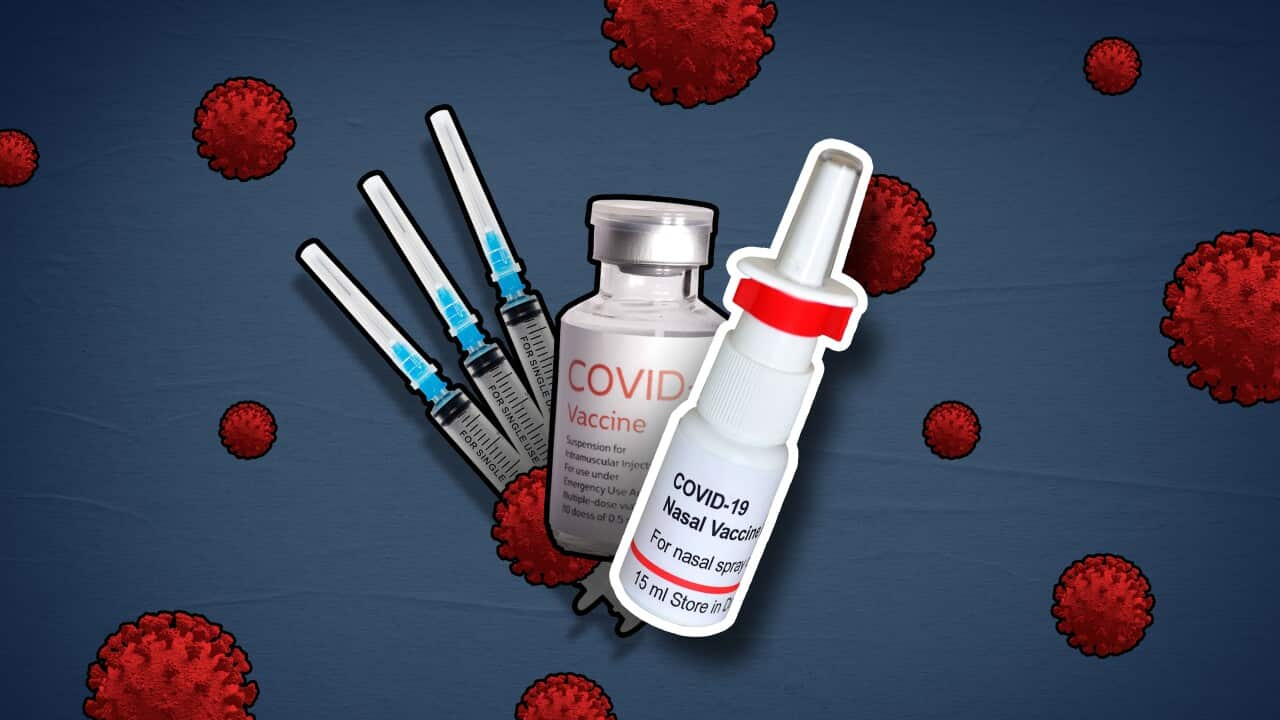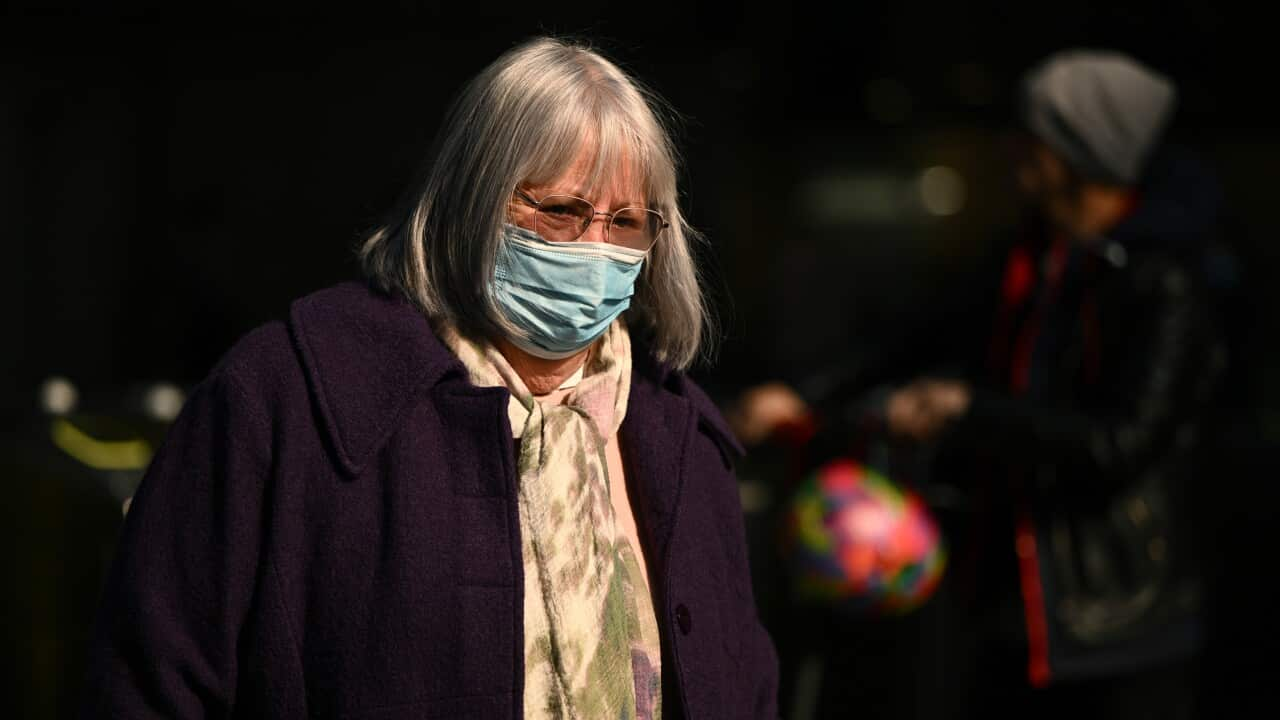

8 min read
This article is more than 1 year old
Feature
From needle-free ‘patches’ to nasal sprays: What’s next for COVID vaccines?
As Eris, a new SARS-CoV-2 sub-variant, takes hold around the world, here's what kind of vaccines could be on the horizon.
Published 14 August 2023 5:34am
By Emma Brancatisano
Source: SBS News
Image: Years into the COVID-19 pandemic, what could the next generation of vaccines look like? (SBS News)
More than three years into the COVID-19 pandemic, efforts to develop more effective vaccines continue as new variants emerge.
The , is becoming one of the most prevalent in the United Kingdom and the United States.
Some 68 known cases have so far been reported in Australia, according to the University of New South Wales Kirby Institute.
Meanwhile, global clinical trials for hundreds of COVID vaccine candidates are underway.
According to the World Health Organization's latest snapshot, 199 candidates were in pre-clinical development as at 30 March 2023.
There were 183 in human clinical trials, 50 in phase III (on larger populations and in different regions and countries) and 11 in phase IV surveillance, which is conducted after a vaccine is licensed and available to the public.

Hundreds of clinical trials for COVID vaccine candidates are underway, according to the World Health Organization. Source: SBS News
"There's still a lot of energy being put into vaccine development," said Nicholas Wood from the National Centre for Immunisation Research and Surveillance (NCIRS). He is also a professor in clinical vaccinology at the University of Sydney.
Can current vaccines protect against Eris?
While experts say new variants are expected as the SARS-CoV-2 virus that causes COVID-19 replicates, they pose challenges when it comes to vaccine protection.
"The general idea is, if the virus varies itself, does the vaccine that we have been using against a previous variant still work?" Wood said.
He compared this to influenza vaccines, which are updated to cope with or match the virus that is circulating year after year.
"What we have been doing with COVID vaccines is that the two leading companies - Pfizer and Moderna - with the messenger RNA (mRNA) technology have been able to vary the mRNA code to design specific variant vaccines," Wood said.
"What they've been doing in those vaccines is effectively combining a little bit of the original virus and the variant strains - so it's called a bivalent vaccine."
Professor Adrian Esterman, chair of Biostatistics and Epidemiology at the University of South Australia, said the formal name for Eris is equivalently known as XBB.1.9.2.5.1, which means it is a "recombination of previous subvariants".
He said current mRNA bivalent vaccines - which contain the original strain and that which protects against B.A.4/5 - will still give some protection against new XBB subvariants, including Eris.
But he hopes plans for an updated monovalent - or single - vaccine could provide better protection.
Push for an updated monovalent COVID vaccine
In recent months, Pfizer-BioNTech and Moderna submitted applications for authorisation of XBB.1.5-adapted monovalent vaccines to overseas regulators, including the United States Food and Drug Administration (US FDA) and European Medicines Agency (EMA).
This followed a recommendation from the WHO to update COVID-19 vaccine antigen composition to enhance immune responses to circulating variants.
A spokesperson for the Therapeutic Goods Administration (TGA) said it has not received any application from any pharmaceutical company to register an XBB vaccine for use in Australia.
"Although we cannot compel a sponsor to submit an application, the TGA would welcome applications for COVID-19 vaccines targeting the XBB variants," the spokesperson said.
"The TGA is in regular contact with the vaccine sponsors to ascertain their plans for future applications."
The TGA is aware of overseas applications for authorisation and works closely with its international counterparts, the spokesperson said.
But the TGA will "independently review the data provided by the sponsor and make its own decision based on the Australian context".

Government figures from August show the percentage of people from different age groups who have had a COVID booster in the last six months. Source: SBS News
What other COVID-19 vaccines are on the horizon?
Esterman said companies around the world are developing a "huge gamut" of vaccine types.
He said this comes at a time when vaccination uptake is dwindling, with figures showing less than 50 per cent of older Australians are up to date with their COVID boosters.
According to the government's latest figures as of 4 August, 2,131,462 Australians over the age of 65 have had a booster in the last six months, around 47.7 per cent of the total age group.
Among younger Australians, 6.5 per cent of people aged 30-49 and 4.2 per cent aged 18-29 had a booster in that time period.
Needle-free vaccines
For some people, the prospect of getting a needle in the arm isn't a welcome one.
Esterman said plans are underway for different kinds of needle-free vaccines, including nasal sprays or inhalants, some of which have already been authorised for use in India and China.
He said these have the potential to be "game changers" because of where they're administered.
"They actually put the vaccine right where the virus goes into the body, which is in the mucosa in the nasal system and in the throat," he said.
"Because of this, they have the potential to stop it in its tracks, and stop it from replicating in the first place."
Researchers at the University of Sydney are working to test a needle-free vaccine 'patch' for at-risk groups. The patch or device is coated with a vaccine formulation with the goal of delivering it to cell layers immediately under the skin, which are rich in immune cells.
As of November last year, the vaccine technology was under development and has not been approved for use.

Other types of COVID-19 vaccines could be on the horizon. Source: AAP / Peter Byrne/PA/Alamy
Live-attenuated vaccines
Another approach could be using what's known as live-attenuated vaccines.
"Current vaccines are derived based on small particles of the virus, but there aren't any vaccines available for the full virus," Esterman said, referring to COVID vaccines which train the immune system to attack the spike protein on the virus's surface.
"These live-attenuated vaccines should work better because they expose the body to a much greater proportion of the virus," he said.
Using a whole, live virus involves weakening it to ensure it is no longer deadly or can cause disease.
Esterman said this is not suitable for people with impaired immune systems.
Broad-spectrum vaccines
Esterman said a number of groups around the world are developing what's called a pan-coronavirus vaccine - or a broad-spectrum vaccine.
"These could actually protect against any variants of coronavirus - not just SARS-CoV-2 but other types of coronaviruses as well," he said.
"That's the most exciting thing that's happening. There are none in clinical trials at the moment, but they are being developed.
"I think that's the way of the future and will protect us from future pandemics."
Will vaccines ever be able to protect against COVID infection?
Wood said some next-generation vaccines are being designed to strengthen our immune response.
"The vaccines that we're using at the moment are good at protecting us against severe disease - which means less hospitalisations and less deaths - but maybe not ideal at stopping infections," he said.
Esterman agreed.
"When the SARS-CoV-2 virus first started circulating ... we had no idea whether we could get a vaccine against it," he said.
"Then, of course, we managed to get these mRNA vaccines, and they were very effective against the [original] strain.
"But because the vaccine has now mutated so much, they now provide limited protection.
"One of the big things that we have to do now is to try and produce vaccines that can stop infection - or, at least, reduce it right down."
A spokesperson for the Department of Health and Aged Care said the Australian government has entered into five separate agreements for the supply of COVID-19 vaccines, and has purchased sufficient doses to complement current and future booster requirements "and any new or remaining primary course vaccinations".
"This diverse portfolio of vaccines provides Australians flexibility of choice and enables the government to address variants of concern in the future," the spokesperson said.
"The Department works closely with manufacturers to ensure access to the most updated vaccines. Only vaccines that have been approved by the Therapeutic Goods Administration may be supplied in Australia."



